Swedish trade with Britain and Allies

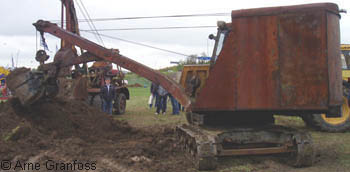 UNDER CONSTRUCTION Version 0.4
UNDER CONSTRUCTION Version 0.4
|
Sweden in World War II - across borders
|
 |
![]()
This page includes trade between Sweden and other not warfaring countries, which also meant that ships had to pass Skagerak between Denmark and Norway.
![]()
When World War II was imminent, there was production in Sweden of Bofors guns for the British Royal Navy. [s38]
![]()
In October 1939 Britain had sent a representative for the "British Iron and Steel Federation" to Sweden, to place an order for ball bearings and special steel. Another representative, George Binney, was sent to Oslo on 9 December 1939, and four days later he came to Stockholm. He began to establish contacts and was met in a positive way, but everyone said that business had to be done according to strict neutrality. Binney also had the task to report everything that could be of interest for the British military intelligence, but without contact with these organisations in Norway and Sweden. [s48]
The British import from Sweden followed an agreement closed in October 1939, based on the figures from 1938. A similar agreement had been closed with Germany. In early 1940 Binney also learnt that a French trade delegation visited Stockholm. France had not imported so much from Sweden earlier, but now were willing to pay more for the goods. [s48]
Svartön sailed from Narvik towards Middlesbrough on 3 January 1940, when she was torpedoed 5 nautical miles from Kinnaird Head. [s73]
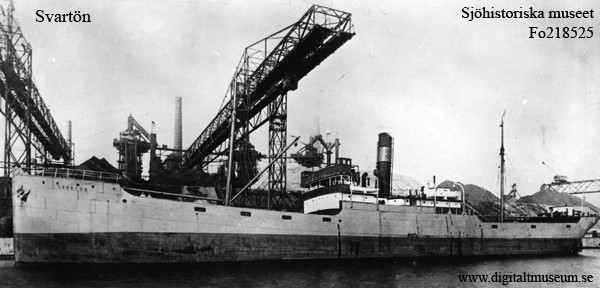
![]()
Binney was in Trondheim on 9 April 1940, and got a phone call from Oslo with a warning about the German attack. Within forty minutes he was on a train for Sweden. [s48]
About 20 percent of the British need for ball bearings had to be imported in peacetime, and the war production incresed the needs. The high quality Swedish ball bearings were important for the British industry, as were a variety of iron and steel products. [s48]
In May Britain acted to preserve the trade agreements with Sweden. Britain ordered finished products to be stored in suitable places in Sweden waiting for shipping possibilities and saw to that Swedish companies were paid. Sweden accepted the British strategy, but there was a fear that longtime storage would lead to protests and threats from Germany. [s48]
Binney managed to send one smaller load via the Finnish port Petsamo, in the north of Finland towards the Arctic Ocean. The shipment went via the USA to Britain. One larger shipment went via the Soviet Union, the Caspian Sea, the Persian Gulf to Britain. These shipments took months to get to Britain. Then Finland lost the war with the Soviet Union and Germany occupied the north of Norway. [s48]
When France capitulated to Germany, the British took over the French orders from Swedish companies. Besides the urgent need for the products in Britain, there was also a wish to prevent higher exports from Sweden to Germany. [s48]
Binney was urged by British authorities to get the much needed products to Britian. But, how? The only reasonable way seemed to be to break the German blockade in Skagerak, between Denmark and Norway. However, both warfaring parts had announced that they had laid mines in the area. [s48]
One possible instrument was the Norwegian ships that were waiting in Swedish harbours. Read more about that on the page Norwegian ships in Sweden (opens in new window). [s48]
![]()
In mid May 1940 Brita sailed from Uddevalla in Sweden with paper pulp, with destination Rouen in France. On 25 May she was commandeered by German authorities in Bergen in Norway, and "price doomed" (?) half a year later by a German court. [s73]
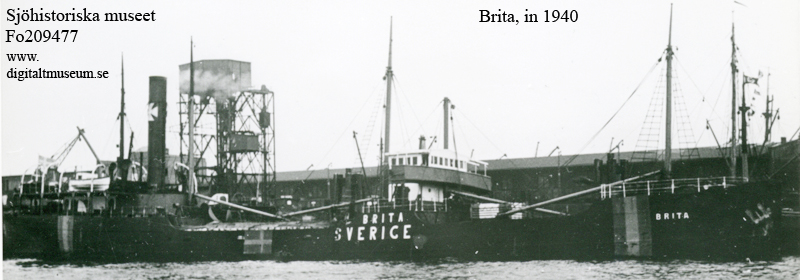
In the early summer of 1940 the smaller Swedish steamship Nora managed to sail through Skagerak to Britain with timber. [s48]
![]()
 In the late 1920s a powerful national radio broadcasting station had been built in Motala in southern Sweden. Among the necessary parts in the transmitters
were fragile radio valves manufactured in Britain. There was a shortage of those valves in 1940, but Sweden managed to purchase four of them in Britain.
Due to the war in Denmark and Norway, they were transported by ship to the Finnish port Petsamo far north at the Barents Sea. From there they were sent by
truck and train southwards. When the railway wagon arrived to the railway junction in Mjölby, not far from Motala, three of the valves were intact. There a shunting mistake
made the wagon crash, so the remaining valves were destroyed. [s26]
In the late 1920s a powerful national radio broadcasting station had been built in Motala in southern Sweden. Among the necessary parts in the transmitters
were fragile radio valves manufactured in Britain. There was a shortage of those valves in 1940, but Sweden managed to purchase four of them in Britain.
Due to the war in Denmark and Norway, they were transported by ship to the Finnish port Petsamo far north at the Barents Sea. From there they were sent by
truck and train southwards. When the railway wagon arrived to the railway junction in Mjölby, not far from Motala, three of the valves were intact. There a shunting mistake
made the wagon crash, so the remaining valves were destroyed. [s26]
The Swedish use of the Finnish ice-free port Petsamo took place for some months between the German occupation of Norway on 9 April 1940 and the Soviet Union attack on Finland on 30 November 1940. This traffic with trucks was expensive and had hazards for the drivers, and only managed to cover a few percents of what Sweden needed. [s64]
![]()
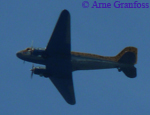 There was an ongoing courier plane traffic between Britain and Sweden. [s48]
There was an ongoing courier plane traffic between Britain and Sweden. [s48]
Even during the war, Sweden had some export of ball bearings to the Allies. There were transports with cargo planes from the USA that fetched the cargo from Swedish airfields. [s19]
Parts for British fighters and bombers were also freighted by British planes. [s36]
![]()
The British had made one successful blockade break in early 1941, with Norwegian ships that were in Sweden at the time Germany attacked Denmark and Norway. One later attempt, in March/April 1942, to freight cargo from Sweden to Britain with other Norwegian ships had caused heavy losses. [s48]
See page "Norwegian ships in Sweden".
Britain still needed special steel and ball bearings from Sweden for their war industry, but it would not be possible to use other Norwegian ships that were in Sweden. Norway refused to let ships sail without escort from the British navy, Britain had already broken Swedish neutrality by the smuggle of anti-aircraft weapons into Sweden and to Norwegian ships that were used during the second blockade bust, and the British navy refused to risk their ships by sailing back and forth through Skagerak - between the German Luftwaffe bases in Denmark and southern Norway, and where there were many German warships. [s48]
Then George Binney, who had arranged the two blockade busts, presented another plan. A group of British fast smaller motor gun boats should meet the two Norwegian ships (that had returned to Gothenburg during the previous attempt to break the blockade) just outside Swedish waters, and transfer weapons and trained sailors to the Norwegian ships. [s48]
However Sweden had promised Germany not to let those two ships leave Gothenburg, and even had attached obstructions in the harbour to prevent the ships from leaving. Once again Sweden was in the position where either Britain or Germany, with whom the agreements about the granted "lejdtrafiken" traffic had been made, would be dissatisfied and stop this for Sweden important import channel. German threats made Sweden delay the operation for the rest of 1942. [s48]
![]()
The Allies demanded that the two Norwegian ships "Dicto" and "Lionel" should be allowed to sail from Sweden, with threats to stop the safe-condutc traffic with Swedish import of oil and other products. [s58]
The Germans pressed Sweden to keep the two ships in Gothenburg harbour, or else they would stop Swedens safe-conduct traffic. [s58]
In the autumn of 1942 the head of the Swedish Foreign Ministry visited London and Washington for trade negotiations. More oil was one vital issue. He came back to Sweden without having given in on Allied demands, but had no positive results either. When the leader of the Conservative party read a report from the trade negotiations, he noted that the Americans and the British had acted far worse against Sweden than the Germans had. [s58]
(I will not describe Swedens various negotiations with the belligerents in depth, but just give some glimpses of "the stick and the carrot" type of demands and wishes that Sweden had to handle. My note.)
The Swedish navy suffered from lack of fuel oil for escort of civil ships in Swedish waters during the period June - October 1942 when Soviet Union submarines were active in the Baltic Sea. One reason was that the Swedish tanker Sveadrott with oil for the Swedish navy was denied departure from the USA. For a period only coal-fired naval ships were used for escort duty. [s68]
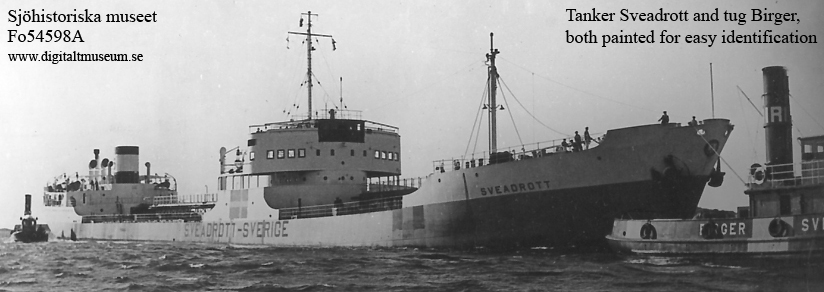
![]()
On 13 January 1943 Sweden gave the ships permission to leave on 17 January, and anchor in a fjord north of Gothenburg where they could wait for suitable bad weather. The day after, Sweden informed Germany about their decision. Germany stopped the "lejdtrafiken" and increased the patrol of Kattegat and Skagerak. Then Sweden demanded that the Norwegian ships had to leave the fjord already at the 19 January, and the political discussions were running again. [s48]
With suitable weather the British fast vessels left their port in the afternoon of 4 February to sail to the Swedish territorial border, and meet the Norwegian ships. The following day they were informed that the German cruisers Hipper and Köln with destroyers and other escort ships were on the way to the area. Also, a storm forced the smaller vessels to reduce their speed. They had to return, and when they got back to port they had got damages. The Norwegian ships were still in Sweden. [s48]
On 5 March the British government was informed that British production of some special ball bearings could not be increased for at least twelve months, and new factories that were planned would not be in function until a year later. Only Sweden could deliver these ball bearings, and what Britain managed to import from Sweden by planes could be measured in kilograms instead of the needed tonnes. On 13 March they were told that if the aircraft industry only could get 100 tonnes of these ball bearings from Sweden, it would be sufficient for 75% of the work on fuselages for 1200 Lancaster planes and 60% of the fuselages for 1600 Mosquito planes. Even a small cargo ship from Sweden could carry as many ball bearings as 40 Lockheed air transports from Sweden. [s48]
This information gave Binney a new idea. To break the blockade with fast motor gun boats. The plan was presented to Sweden, including the promise that the two Norwegian ships would stay in Sweden for the rest of the war. Sweden was positive initially, but then there was a royal decree from 12 April 1940 that forbade navy ships from warfaring nations to visit Swedish ports. The new operation had to be postponed by the British, to train marchant sailors to man the motor gun boats. This delay gave Sweden the possibility to end the German stop of the Swedish "lejdtrafiken" - and to import necessary goods before the British operation began when the autumn came with longer dark nights, and the Germans surely would stop "lejdtrafiken" again. [s48]
The order to Binney was to freight 400-500 metric tonnes of cargo from Sweden to Britain during the winter season. Each rebuilt motor gun boat could carry 45 tonnes. The boats were armed and fitted with charges to sink the boats if there was a risk of capture by the Germans. With civilian merchant sailors they would not be navy vessels, and would be permitted to visit Swedish ports. [s48]
Five boats were built for this traffic, ready for use in October 1943. Until March 1944 they had carried nine loads of ball bearings and special tools for the British aviation industry from Sweden. On the way to Sweden they took oil barrels for the Norwegian ships "Dicto" and "Lionel". [s71]
![]()
![]()
There was an ongoing courier plane traffic between Britain and Sweden, but not between 15 May and 15 August during the Scandinavian summer when the nights were too light. Among the suggestions for transport of ball bearings from Sweden to Britain, was the Swedish idea to establish a military operation during this period to transport goods. The British decided it was worth the risk, and a delivery of five Dakota transport planes would increase the possibilities to import larger quantities. However, the courier traffic was run by the civilian British Overseas Airways Corporation, and they refused to use the only Dakota plane that was delivered before the period. Instead smaller Mosquito planes had to be used. [s48]
In the early summer of 1943 another Brit who worked with Binney in Sweden, Waring, flew to Britain from Stockholm in a Lockheed plane. Together with the director of the Swedish company SKF in Luton, he should return in mid June. The purpose was to make large orders of ball bearings from the Swedish industry, mainly to block production for expected German orders. Clear weather delayed the possibility to fly for several days. Since it was urgent for the British to get them to Sweden, they would after several days be transported by two Mosquitos. These were unarmed and had civilian markings. One passenger in each plane, on the consignment note specified as one piece of Waring and one piece of Siberg. The passengers had to sit in the bomb bay for 3,5 hours. They landed in Sweden around 3 o'clock in the night. [s48]
The idea had been to use the two Norwegian ships as depot vessels for the motor gun boats, where cargo could be reloaded to the smaller boats, but Sweden refused this idea - according to Swedish law such activities could only take place in a few selected harbours with customs offices. During discussions it was agreed to use the small port town Lysekil instead, an area that was a forbidden zone for foreigners in Sweden - so it was difficult for foreign agents to work in that area. The goods could be sent to Lysekil on railway, and it was possible to store 250 tonnes of ball bearings in a storage building. [s48]
(If you think that several decisions seem more or less odd - I agree with you. My note.)
After several new discussions, political pressure from Britain, fear of a German stop of the Swedish "lejdtrafiken" before three awaited Swedish ships from South America arrived to Sweden, and other issues, the two Norwegian ships arrived in a fjord near Gothenburg. On 9 September 'the Swedes gave up their last resistance and promised all possible assistance in Lysekil'. However Sweden placed obstructions to prevent the ships from leaving the fjord, a navy vessel was anchored nearby and an anti-aircraft battery was placed on land. As soon as the Norwegian ships left Gothenburg, the Germans once again sent destroyers to Kristiansand in southern Norway to increase the possibility to stop blockade busters. A British meteorologist was sent to Sweden by plane to establish a station on one of the Norwegian ships, and also three marine technicians arrived. [s48]
The Norwegian ships were prohibited to use their radio communication in Sweden, so all contacts with Britain was sent via SOE (the British Special Operations Executive) group in Gothenburg. Technical problems with the engines in the boats prevented the operation to begin in the moonless period in September. Meanwhile the secrets about the operation began to leak to the Germans. [s48]
On 26 October 1943 five motor gun boats left Britain. The plan was to make the journey as a group, with the combined firepower as protection. The group was partly scattered due to engine problems and bad sight, they were discovered by German planes and attacked, and in the evening Binney decided to go back to Britain. If they managed to reach Lysekil with only two boats, it would not be worth the journey - that would have made the Germans aware of the new operation and caused higher risks for the following journeys. [s48]
But, one of the boats had not received the order to return. During the following night they managed to get through Skagerak. Around half past 3 in the night they identified the lighthouses on the Swedish islands Väderöbod and Hallö, and they managed to pass the German patrol boats and the German convoy route between Denmark and Norway. Before they sailed into Swedish waters, they dumped all ammunition but one round for the anti-aircraft guns, and also oil and fresh water that would not be needed for the return journey. This made it possible to carry more cargo. They sent a signal for the mandatory pilot, but did not get an answer. A Swedish merchant ship was waiting for pilot, but the Brits decided it was too risky to wait at the island. When daylight arrived, they sailed on among the islands with two red merchant ship flags. [s48]
The order that the boats should return to Britain had not been forwarded via the SOE to contacts in Sweden, so a group of Brits and Swedes were waiting for them. Among others a couple of ambulances, in case some of the sailors had been injured during German attacks. Swedes in fishing boats and in Lysekil cheered. It was the first ship with the merchant ship flag that had come to the Gothenburg area for 3,5 years. In Lysekil they berthed in view of a villa that turned out to belong to the German deputy consul. [s48]
With an armed Swedish escort the sailors were taken to the public baths, a hotel with breakfast and beds and a meal, to the cinema, and back to the hotel for some entertainment and a nights sleep. Meanwhile the boat was unloaded and loaded, and got service. The next morning, 29 October, the sailors were back on the boat. [s48]
The plan was that the motor gun boats should sail to the two Norwegian ships that were anchored in Brofjorden, and wait there for suitable weather for the return journey to Britain. However the ships officers found it most suitable to leave the same day. The weather was promising, they had received the message that a German submarine was on the way to Brofjorden, and another message that the German radio had broadcast the news about a British boat in a Swedish harbour - that never would make it back to Britain. [s48]
The German deputy consul had during the morning travelled to Gothenburg and informed the consul-general about the British motor gun boat. He called the German legation in Stockholm, but since the boat had the red merchant ship flag they could not act against Sweden. That phone call was intercepted by the Swedes, and the British legation in Stockholm was informed. [s48]
After a short time the Germans stopped the Swedish "lejdtrafiken", and a little later information about the British ship was sent to German patrols in Skagerak and the North Sea. Meanwhile five Norwegians came onboard the boat, as passengers. [s48]
Half past four in the afternoon, in the autumn dusk, the British boat and a Swedish pilot boat left Lysekil. The lights on both boats went out, and the Swedish pilot left the British boat. In the morning of 31 October the boat arrived to its port in Britain, with some 40 metric tonnes of much wanted cargo. [s48]
This traffic continued, but not without problems and losses of men. [s48]
When one of the motor gun boats left Brofjorden, the crew on the Swedish navy vessel who had escorted her to the fjord was cheering. The Brits also had got fresh water and bread. [s48]
One time when a boat had to return to Sweden due to bad weather, the captain had made as he promised the Swedish pilot - to destroy the nautical chart he had received. At arrival the boat had a damaged transmission part, and George Binney (who was on that boat) asked for a spare part by plane from Britain. The more than 1000 kilogram heavy part arrived on the 4th day. The boat could have been repaired in Lysekil, but Binney instead asked for permission to take the boat to a shipyard in Gothenburg. With Swedish escort the journey to Gothenburg began. Before entering the harbour area the Brits were ordered to leave all ammunition and vital weapon parts on land. The boat continued, and was fired on from a Swedish fort (no hits) - to the embarrasment of two Swedish officers who were on board. The arrival of a ship with a merchant flag in Gothenburg harbour, the first for more than 4 years, was met with cheering and the V sign. In Gothenburg there were no restrictions for the British sailors. During the following week it was close to a gangfight with a group of Germans. It happened that Brits and Germans fought in another way - on public places where they tried to sing their homelands songs higher than the other group. After the repair the boat left Gothenburg, and picked up the ammunition and weapon parts - that had been left without protection from the weather. The British legation protested, and the Swedish Naval Forces apologized. [s48]
Oh yes, there were some discussions between Germany and Sweden, and Britain and Sweden, and ... And there were incidents also when the boats were in Sweden. One of the incidents was a visit on a motor gun boat by a Swedish officer and two radio specialists from the Swedish Postal organization in Gothenburg. The British soon found that they were not - they had been sent by the Swedish Naval Forces in Stockholm, and one of them was the leader of a Swedish wireless telegraph company, which was a daughter company to the German company AEG. Sweden apologized. It had not been a German idea, it came from Swedens National Defence Research Establishment. [s48]
Between November 1943 and March 1944 the motor gun boats freighted 347 metric tonnes of supplies to Britain. Foremost ball bearings but also machine tools, measure instruments and more. During the same period 88 metric tonnes of goods was freighted by air to and from Sweden. [s48]
![]()
From September 1944 a new attempt to break the blockade was made by 3 of the motor gun boats, with Swedish harbours as the destination. But that is another story, a non-merchant story. [s48]
Well, the boats also freighted more than 63 metric tonnes of special steel on their return journeys to Britain. Steel for tracks on tanks, that Britain could obtain only from Sweden. [s48]
![]()
In January 1945 Germany had tightened the mine field blockade in Skagerak, and very little goods arrived by ship to Sweden. [s49]
![]()
The war in Europe came to the end. 48 hours after the V-day began, a British motor gun boat was on the way to Gothenburg. It would be a peacetime visit to Gothenburg, and to participate when the 2 Norwegian merchant vessels finally left Sweden. On the way to Sweden, the boat hit a mine and several of the crew members were killed. The survivors were rescued after 4 days. [s48]
![]()
2015-08-29. www.granfoss.se. Text/pictures: Arne Granfoss